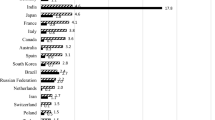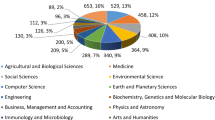Abstract
This paper presents a comparative study of research performance of 11 East and Southeast Asian countries based upon the total number of peer-refereed international publications (PRIP) per one million people (research intensity), the mean citation, and the contribution of domestic authors in PRIP production. Large gaps are observed within the region in the three above dimensions reflecting the disparities among countries in the levels of socio-economic development. Vietnam is among countries of low research intensity in the region having 9.3 PRIPs per one million people in 2008. Other weaknesses includes the heavy reliance on foreign authors, the low numbers of PRIPs on applied and multidisciplinary fields, and the modest contribution from Vietnamese universities in PRIP production. The paper suggests approaches that should be taken for enhancing research capability and reshaping science and higher education system in Vietnam.





Similar content being viewed by others
References
Bernardes, A., & Albuquerque, E. (2003). Cross-over thresholds, and interactions between science and technology: Lessons for less developed countries. Research Policy, 32, 865–885.
Butler, L. (2003). Explaining Australia’s increased share of ISI publications—the effects of a funding formula based on publication counts. Research Policy, 32, 134–155.
Ca, T. N., & Hung, N. V. (2008). The evolving role of academic institutions in the knowledge economy: The case of Vietnam. ISBN: 978-91-86113-01-8 (2008). Published online at http://developinguniversities.blogsome.com/ by Research Policy Institute, Lund, Sweden.
Dapice, O. (2008). Choosing success: The lessons of East and Southeast Asia and Vietnam’s future, Harvard Kennedy School.
Karlsson, S., & Wadskog, D. (2007). A bibliometric survey of Swedish scientific publcations between 1982 and 2004. Swedish Research Council, May, 2007. http://www.vr.se.
Ministry of Science and Technology (2007). Science and technology in Vietnam in 2007 (in Vietnamese).
SJTU (Shanghai Jiao Tong University). (2008). Academic ranking of world universities 2008. Retrieved September 30, 2008, from http://www.arwu.org/rank2008/EN2008.htm.
Socialist Republic of Vietnam. (2005). Resolution No. 14/2005/NQ-CP on fundamental and comprehensive higher education reform in Vietnam for the period of 2006–2020, November 2, 2005.
THES (2008). The times higher education world rankings. Retrieved September 30, 2008, from http://www.timeshighereducation.co.jk/.
UNDP (2006). Beyond scarcity: Power, poverty and the global water crisis, Human Development Report. UNDP, 1 UN Plaza, New York, 10017, USA.
United Nations. (2005). World investment report–transnational corporations and the internationalization of R&D, New York and Geneva.
Acknowledgments
The author thanks Ben Wilkinson, Susan Phan, Peter K. Pham, and Keith Roberts for their valuable comments. This work was done partly during my participation in the ADB-supported Project on Establishing New Model Universities in Vietnam.
Author information
Authors and Affiliations
Corresponding author
Rights and permissions
About this article
Cite this article
Hien, P.D. A comparative study of research capabilities of East Asian countries and implications for Vietnam. High Educ 60, 615–625 (2010). https://doi.org/10.1007/s10734-010-9319-5
Published:
Issue Date:
DOI: https://doi.org/10.1007/s10734-010-9319-5




